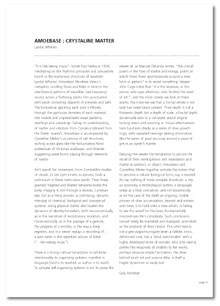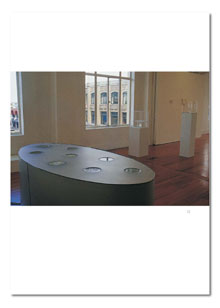 |
|||||||||
|
|
| ...Publications: Annual | ...The Physics Room Annual 2002 | ||||||||||||||
|
AMOEBASE ; CRYSTALINE MATTER “It is like seeing music", wrote Paul Valery in 1936, meditating on the rhythmic pinnacles and concavities found in the mysterious structures of seashells. Lyndal Jefferies' Amoebase literalises Valery's metaphor, scrolling flows and folds in time to the interference patterns of inaudible, low-frequency sound, across a fluttering plastic film punctuated with pools containing deposits of minerals and salts. The turbulence agitating each pool is filtered, through the particular densities of each material, into mobile and unpredictable visual patterns, swellings and subsidings. Taking its understanding of matter and vibration from Cymatics (derived from the Greek ‘waves’), Amoebase is accompanied by Crystaline Matter‘s accretions of salt structures, inching across glass like the hallucinatory floral arabesques of Victorian wallpaper, and likewise suggesting wave forms playing through networks of matter. Art’s search for movement, from Constable’s studies of clouds, to Len Lye’s kinetic sculptures, finds a continuum in these meticulous works. Their finely grained, filigreed and filiated networks evoke the body, imaging it, not through a divisive, Cartesian eye, but as a living process, a continuing, dynamic interplay of chemical, biological and conceptual systems. Living physical matter also locates the dynamics of identity-formation; both macrocosmically, as in the narratives of evolutionary mutation, and microcosmically, as in the passage of a gesture, the progress of a wrinkle, in the way a body registers, and in a sense 'replays a recording of', a past event in the repetitive actions of habit ("...like seeing music"). There is a strong cultural temptation to attribute intentionality to organising systems, manifest in language (God is to seashell, as author is to work). To activate self-organising systems in art, to poise the viewer at, as Manuel DeLanda writes, “the critical points in the flow of matter and energy, points at which these flows spontaneously acquire a new form or pattern" is to reveal something 'deeper'. John Cage notes that “it is the observer, or the person who pays attention, who finishes the work of art.”, and the more closely we look at these works, the more we see that a formal whole is not (and has never been) present. Their depth is not a Romantic depth but a depth of scale, a fractal depth, dynamically akin to a computer search engine locking down and zooming in. Visual attentiveness here functions ideally as a series of slow growth rings, with repeated viewings adding information like the layers of pearl accruing around a piece of grit in an oyster’s mantle. Denying the viewer the temptation to picture the result of their investigations into modulation and matter as product, or object, Amoebase and Crystalline Matter together activate the notion that to perceive a natural biological form, say, a seashell (to say nothing of more complex structures: a city, an economy, a technological system, a language) solely as a final concretion, and not durationally, as (in the case of the shell) an ongoing, mobile process of slow accumulation, deposit and erosion over time, is to hold onto a view which, in failing to see the wood for the trees, fundamentally misconstrues life's complexity. Such conclusions cannot solely be marketed and displayed, promoted as the products of their creator. The artist here is not a genius/god-surrogate (even a fallible, ironic, dethroned one), but a 'blind watchmaker' with a highly developed sense of wonder, who (she claims) prefers the responses of children to her works, perhaps because simple fascination, the drive behind much art and science alike, is itself a fragile dynamism so easily lost. Sally McIntyre This essay originally appeared in The Physics Room Annual 2002 Order your copy today from The Physics Room ! Related amoebase and crystalline matter
|
||||||||||||||


